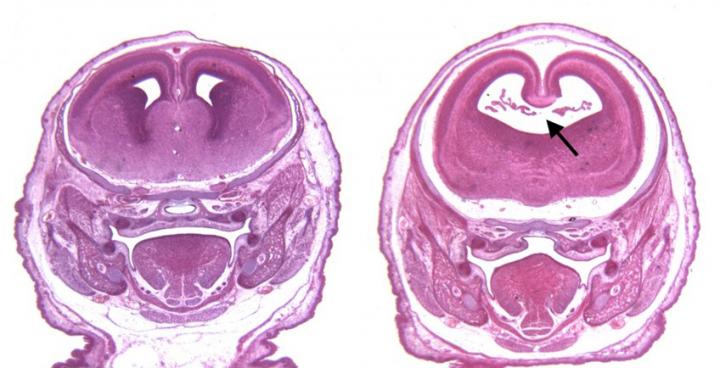|
|
Developmental Biology - Cannabis/THC
Using 'Pot' In Early Pregnancy Disrupts Brain Growth
One time exposure in early pregnancy to cannabinoids (CBs: synthetic or natural) can disrupt embryo development...
According to recent research from the University of North Carolina (UNC) School of Medicine, CBD/THC or "Pot" use during early pregnancy can disrupt fetal brain development. This is the first research in animals (mice) to show that components of marijuana, including its cannabinoids THC and CBD, can cause brain and facial birth defects if used during the first trimester of pregnancy.
A new study published in Scientific Reports, a Nature Research journal, shows how a one-time exposure during early pregnancy to cannabinoids (CBs) — both synthetic and natural — can cause growth issues in a developing embryo.
This is the first research to show such a connection in mammals. The study was performed in mice, which are very accurate models for the development that occurs during early pregnancy.
"The development of the embryo in this time period is very similar across all vertebrates. In this study we also test a synthetic cannabinoid in zebrafish that yielded similar growth deformations as the natural CBs. Having the same results across animal models reinforces our findings."
Scott Parnell PhD, Assistant Professor, Cell Biology and Physiology, Bowles Center for Alcohol Studies, University of North Carolina (UNC) School of Medicine, Chapel Hill, North Carolina, USA, and senior author.
In this study, the brain and facial developmental effects caused by one-time exposure to CBs - CBD and THC (the primary ingredients of marijuana) - are very similar to what is seen in fetal alcohol syndrome (FAS).
Parnell and colleagues also found that when CBs and alcohol were used together, the likelihood of these birth defects more than doubled.
They went on to show that these drugs may be causing defects by interacting on a basic cellular level and disrupting signaling between molecules and cells that control growth and development.
"The interaction between alcohol and CBs we witnessed is very concerning," said the study's first author, Eric Fish PhD and research associate in the UNC School of Medicine Bowles Center for Alcohol Studies. "Previous studies have shown that CBs and alcohol are frequently used together, and for pregnant women we're learning that could be very dangerous to a developing child."
In the study CBs, and CBs with alcohol, were given to mice in varying amounts on day eight of pregnancy, comparable to the third and fourth weeks of pregnancy in humans. This time period is when alcohol and CB exposure is especially damaging to a developing embryo — and before most women know they are pregnant. The CBD amounts administered were within what is considered a therapeutic range for humans. The THC concentration administered was similar to levels reached by a person smoking marijuana.
"It is concerning how little we know about the use of marijuana, its CBs, and products like CBD oil during pregnancy. We know that there is no safe period to drink alcohol during a pregnancy, and I think this research shows the same is likely true of marijuana use."
Scott Parnell PhD.
With the results of these one-time exposures, Parnell and Fish are planning to now test smaller, multiple exposures throughout a pregnancy as a better mimic of real-life use in human pregnancy.
Abstract
We tested whether cannabinoids (CBs) potentiate alcohol-induced birth defects in mice and zebrafish, and explored the underlying pathogenic mechanisms on Sonic Hedgehog (Shh) signaling. The CBs, ?9-THC, cannabidiol, HU-210, and CP 55,940 caused alcohol-like effects on craniofacial and brain development, phenocopying Shh mutations. Combined exposure to even low doses of alcohol with THC, HU-210, or CP 55,940 caused a greater incidence of birth defects, particularly of the eyes, than did either treatment alone. Consistent with the hypothesis that these defects are caused by deficient Shh, we found that CBs reduced Shh signaling by inhibiting Smoothened (Smo), while Shh mRNA or a CB1 receptor antagonist attenuated CB-induced birth defects. Proximity ligation experiments identified novel CB1-Smo heteromers, suggesting allosteric CB1-Smo interactions. In addition to raising concerns about the safety of cannabinoid and alcohol exposure during early embryonic development, this study establishes a novel link between two distinct signaling pathways and has widespread implications for development, as well as diseases such as addiction and cancer.
Authors
Eric W. Fish, Laura B. Murdaugh, Chengjin Zhang, Karen E. Boschen, Oswald Boa-Amponsem, Haley N. Mendoza-Romero, Michael Tarpley, Lhoucine Chdid, Somnath Mukhopadhyay, Gregory J. Cole, Kevin P. Williams and Scott E. Parnell.
Acknowledgments
This research was supported by grants U01-AA021651 and U54-AA019765 from the National Institute on Alcohol Abuse and Alcoholism (NIAAA), part of the National Institutes of Health. This work was done, in part, with the Collaborative Initiative on Fetal Alcohol Spectrum Disorders (CIFASD), which is funded by grants from NIAAA.
The authors acknowledge Drs. Michael E. Charness, Melissa A. Herman, and Sara P. Faccidomo for their comments on earlier versions of this manuscript, Drs. Joyce Besheer and Patrick A. Randall for assistance with the blood alcohol assay, Dr. Ken A. Mackie for his gift of the CB1 antibody used for the PLA technique, Mr. Jeffery F. Matthew for assistance with the PLA technique, and Ms. Deborah B. Dehart for the histological processing. This research was supported by grants U01-AA021651 and U54-AA019765 from the National Institute on Alcohol Abuse and Alcoholism (NIAAA). All or part of this work was done in conjunction with the Collaborative Initiative on Fetal Alcohol Spectrum Disorders (CIFASD), which is funded by grants from the NIAAA. Additional information about CIFASD can be found at www.cifasd.org.
The authors declare no competing interests.
Return to top of page.
| |
|
Nov 11 2019 Fetal Timeline Maternal Timeline News

Images are stained sections of fetal mouse brains. (Left) The brain of a control [NORMAL] mouse. (Right) The brain of a mouse exposed to alcohol and a cannabinoid on the 8th day of pregnancy. Note enlarged cerebral ventricle (BLACK ARROW) caused by loss of midline septal region. CREDIT UNC School of Medicine.
|



